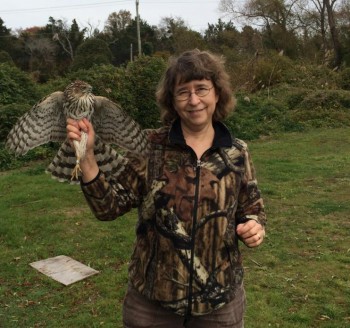Suzanne Amador Kane's Research Takes To The Skies

Associate Professor of Physics Suzanne Amador Kane and a sharp-shinned Hawk, another type of raptor. Photo by Casey Setash.
Details
Haverford Associate Professor of Physics Suzanne Amador Kane uses a combination of physical tools and traditional field biology methods to study biomechanics and animal behavior. Last year she co-authored a paper with recent Haverford graduate Marjon Zamani '13 in The Journal of Experimental Biology detailing the results of an unusual collaboration with falconers around the world who agreed to mount tiny video cameras on their birds to study how falcons pursue their prey. Following on the heels of that work comes a new paper in the same journal, “When hawks attack: animal-borne video studies of goshawk pursuit and prey evasion strategies.” In this study, coauthored by Haverford students Andrew Fulton '14 and Lee Rosenthal '15 and made possible with funding from the Marion E. Koshland Integrated Natural Sciences Center, Kane's group analyzes the visual guidance strategies of another outstanding avian aerialist, the Northern Goshawk, a fast and highly maneuverable bird of prey.
Kane knew that she could only really understand the goshawk's strategy from a bird's-eye perspective. To achieve this, she worked with master falconer Robert Musters and his goshawk, Shinta.“Robert is an inventor and engineer and he designed the camera helmet that Shinta wore,” says Kane, who formulated the research plan and supplied Musters with the tiny spy camera that was mounted on the bird's head. Shinta did her part by flying freely through forests and fields, searching for prey and then hunting it using the same tactics observed for wild goshawks.
After sifting through the hunting footage, Kane found sequences in which Shinta pursued prey, chased after falconry lures and landed on perches. These were combined with videos filmed from the ground by UK falconer David Burn to create a picture of goshawk pursuit and prey evasion strategies. Manually analyzing the motion of background objects in the bird's vision and the position of the target during its approach, Kane and Fulton were able to extract information about the goshawk's trajectory in the majority of attacks and the evasive action taken by the rabbit or pheasant that was in its sights. These were then interpreted using computer models created by Kane and Rosenthal to reconstruct the predator and prey's trajectories and visual fields.
Explaining that goshawks use stealth to spy out their victims from a hidden vantage point before launching an attack, Kane describes how Shinta first made a beeline towards her motionless prey by holding it in the centre of motion of her gaze to minimize the time to impact and optimize the surprise factor. If prey were in motion, she instead flew on the most direct interception course, achieved by holding the prey at a constant angle in her vision as she closed in. Kane explains that this allows the predator to intercepts its victim in the fastest time while also masking the attacker's approach from the victim's perspective. However, once she was within striking range Shinta switched strategy again, flying parallel to the fleeing animal, which gave her time to decide when to strike. Rather than a unified strategy, the goshawk adapts its pursuit to optimize both interception time and maneuverability for the attack.
Having identified the key components of the goshawk attack, Kane says,“One of the other things we wanted to study was how the prey try to evade capture.” Analyzing the escape trajectories of the rabbits and pheasants that successfully eluded capture, Kane, Fulton, and Rosenthal realized that the survivors often made a sharp sideways turn away from the predator.“In our videos you could see that only the sideways motion was effective at breaking the visual fix,” says Kane. Adding that it's challenging for a rabbit or pheasant to outrun or out-maneuver super agile goshawks, Kane suggests,“Maybe what they are trying to do is counter the sensory abilities of the predator. They are trying to take advantage of the way the predator uses its visual guidance to escape.”
Kane is currently busy advising other research groups who are interested in adopting similar approaches to animal-borne video, while working with current Haverford students Carolyn Oehrig and Nathan Gould ('15) on new projects to explore the biomechanics of raptor flight and how birds use calling while flying in flocks.



